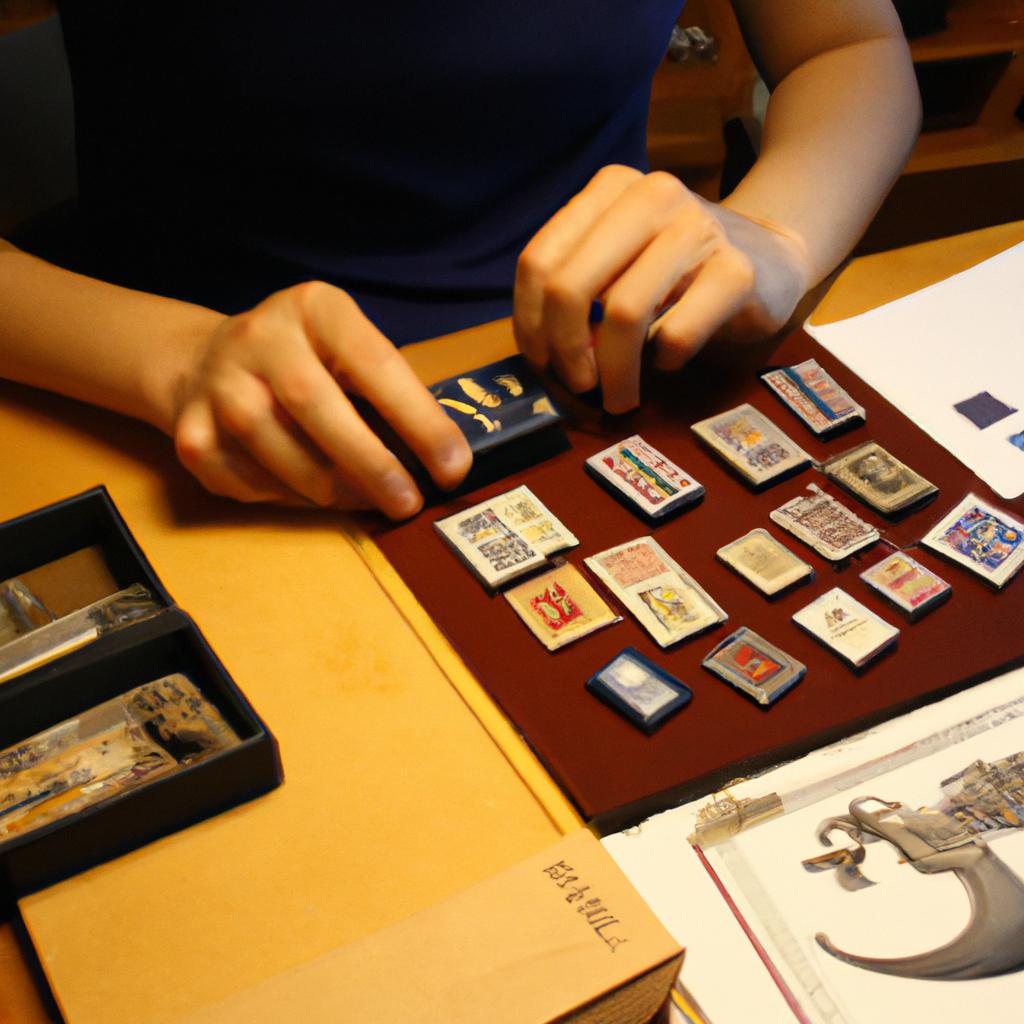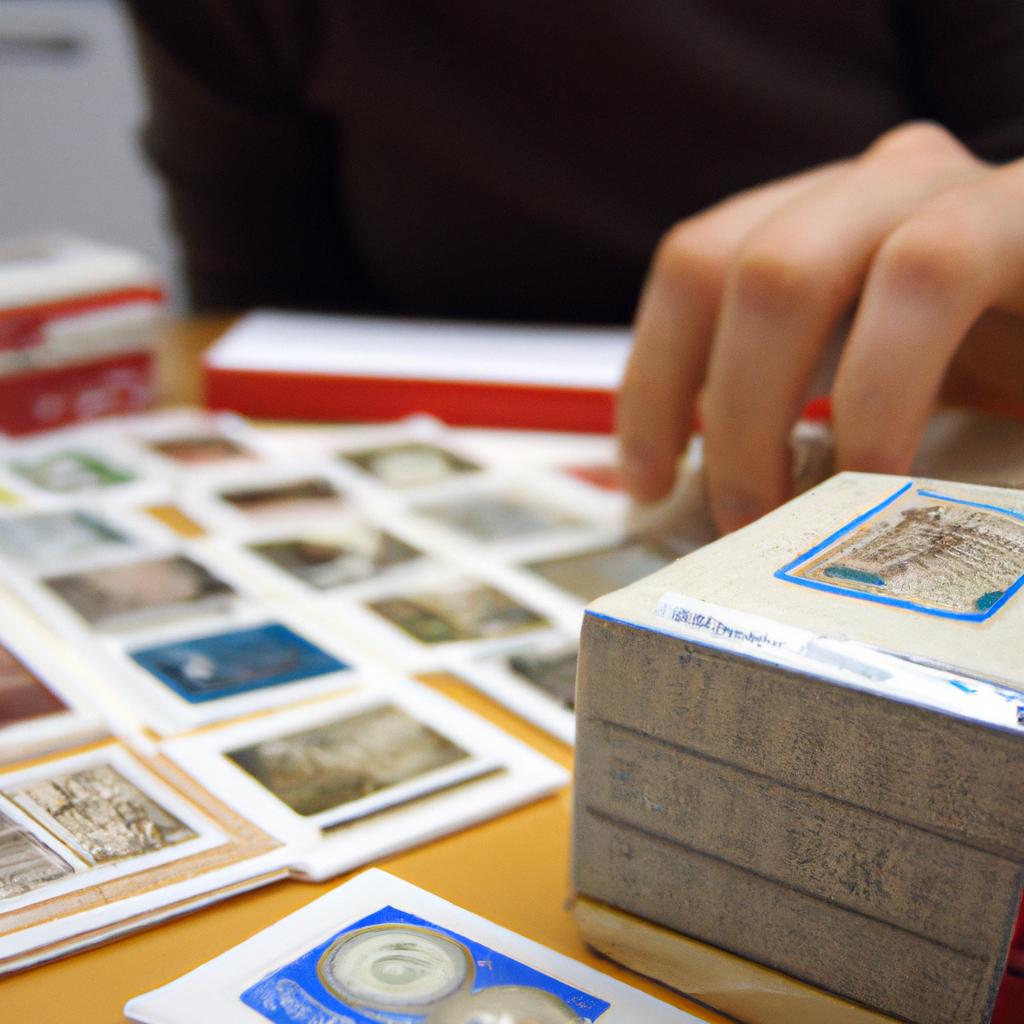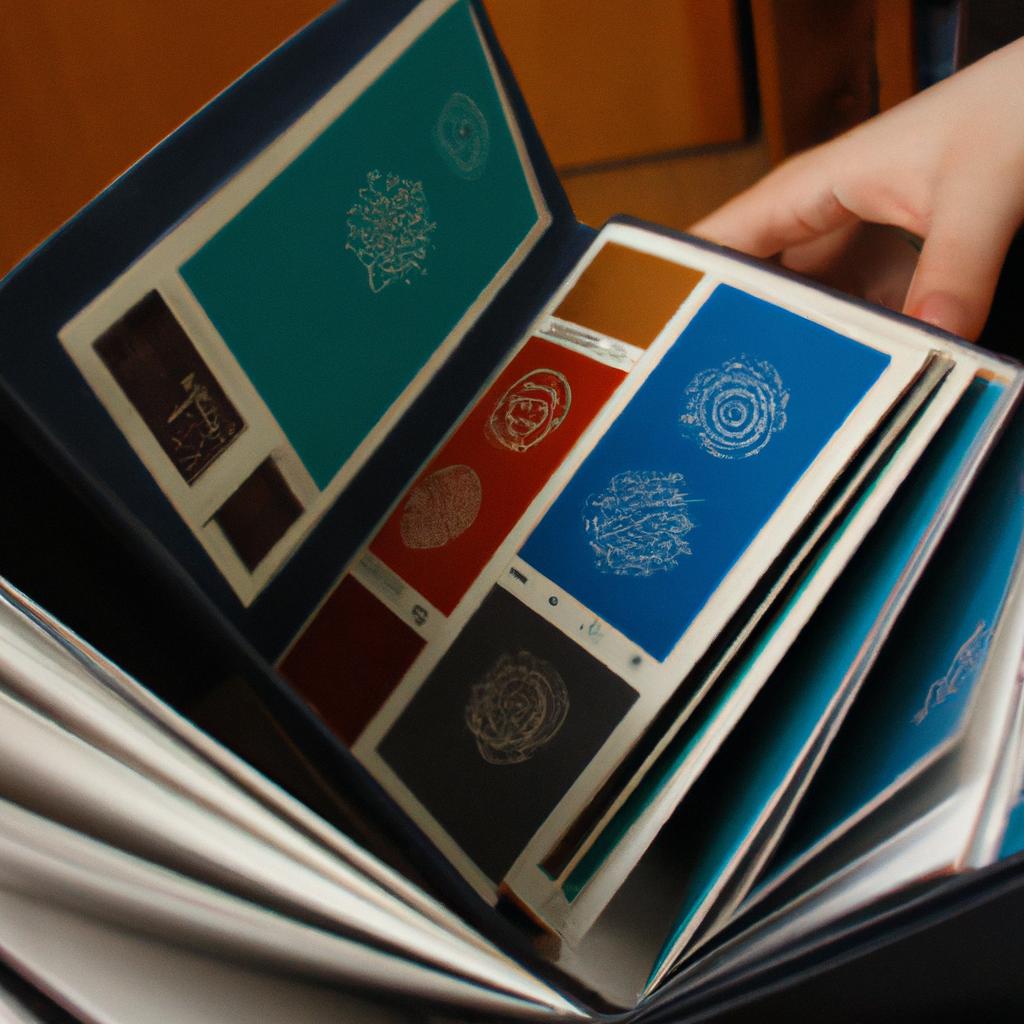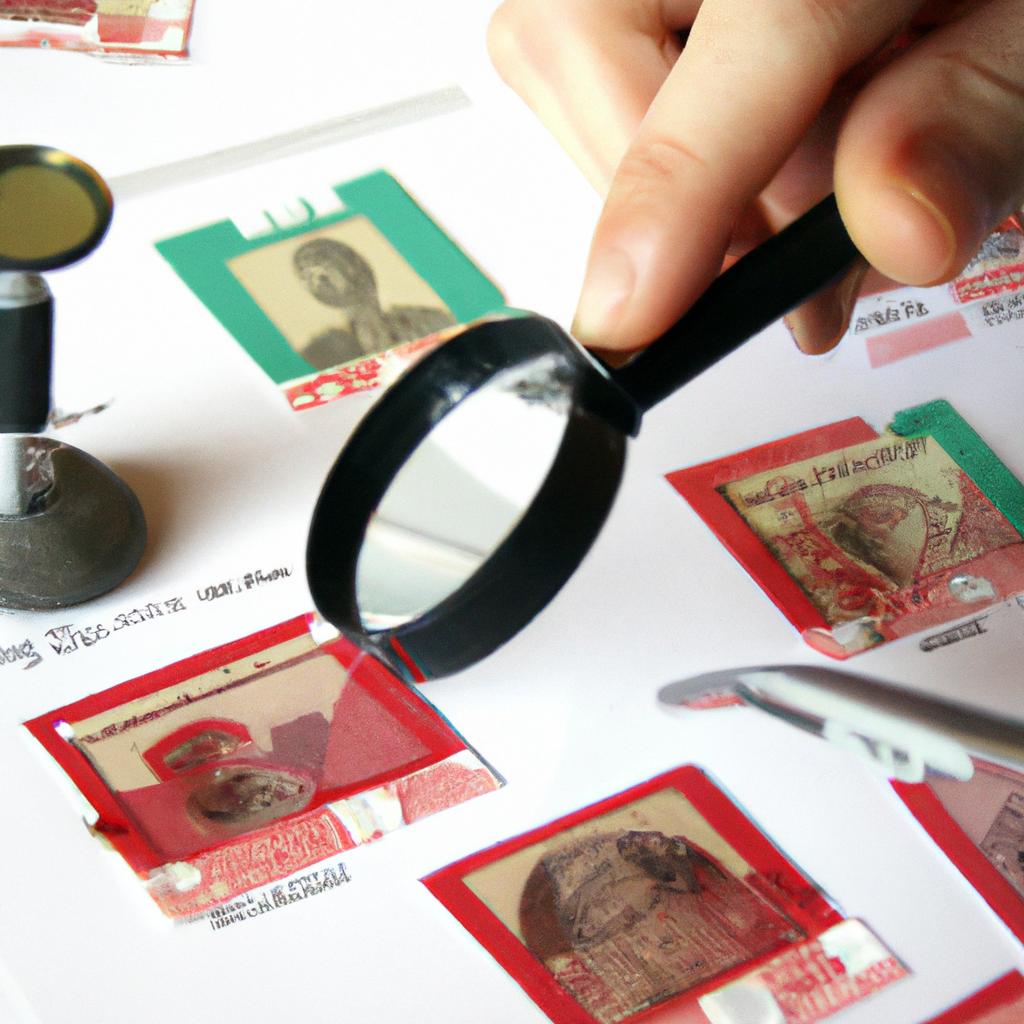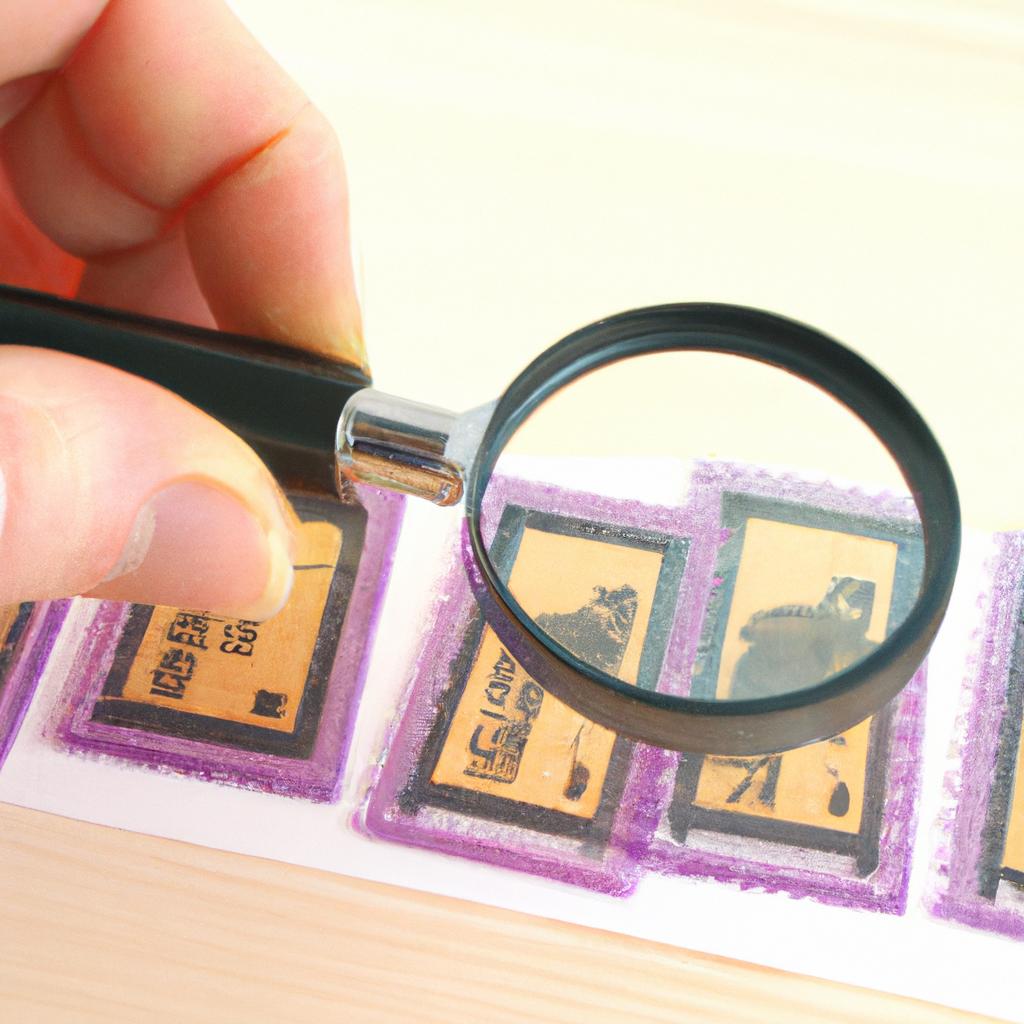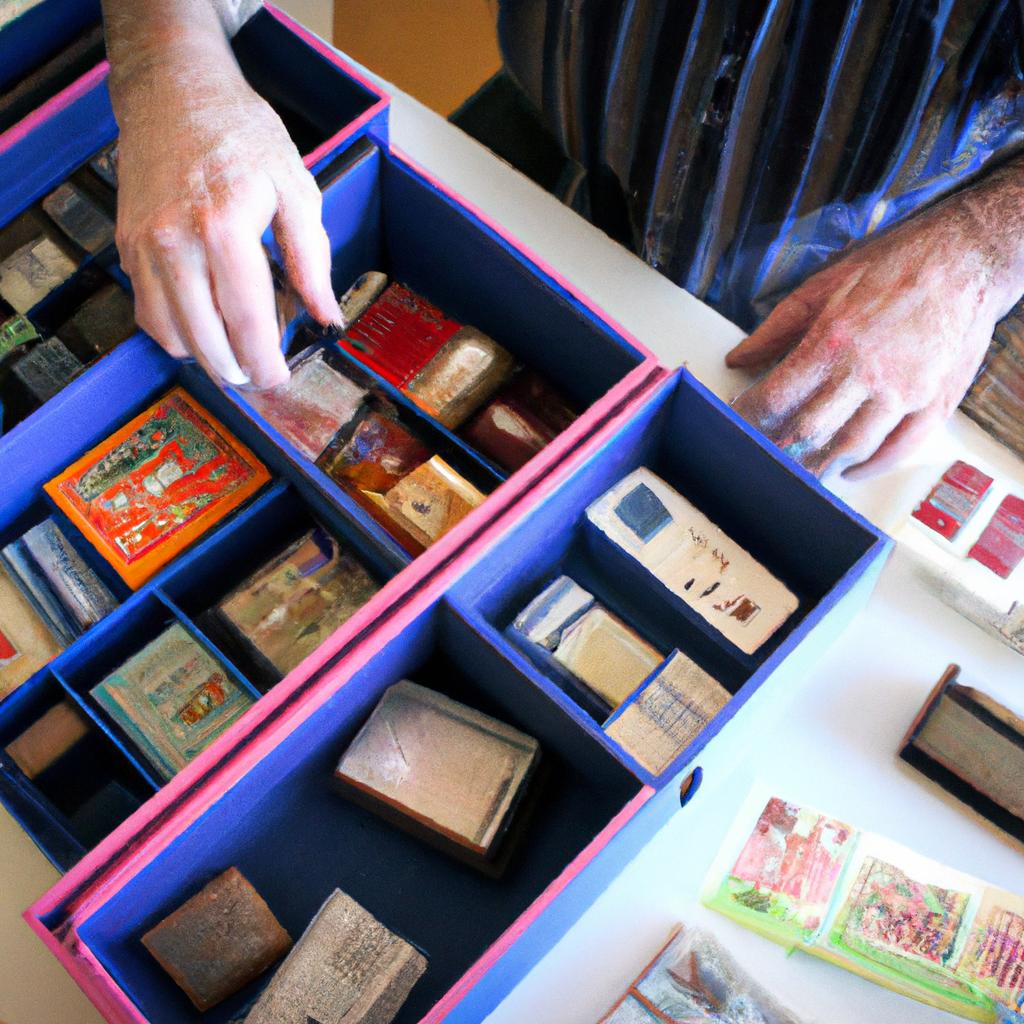History of Stamp Collecting: Antiques and Collectibles Perspective
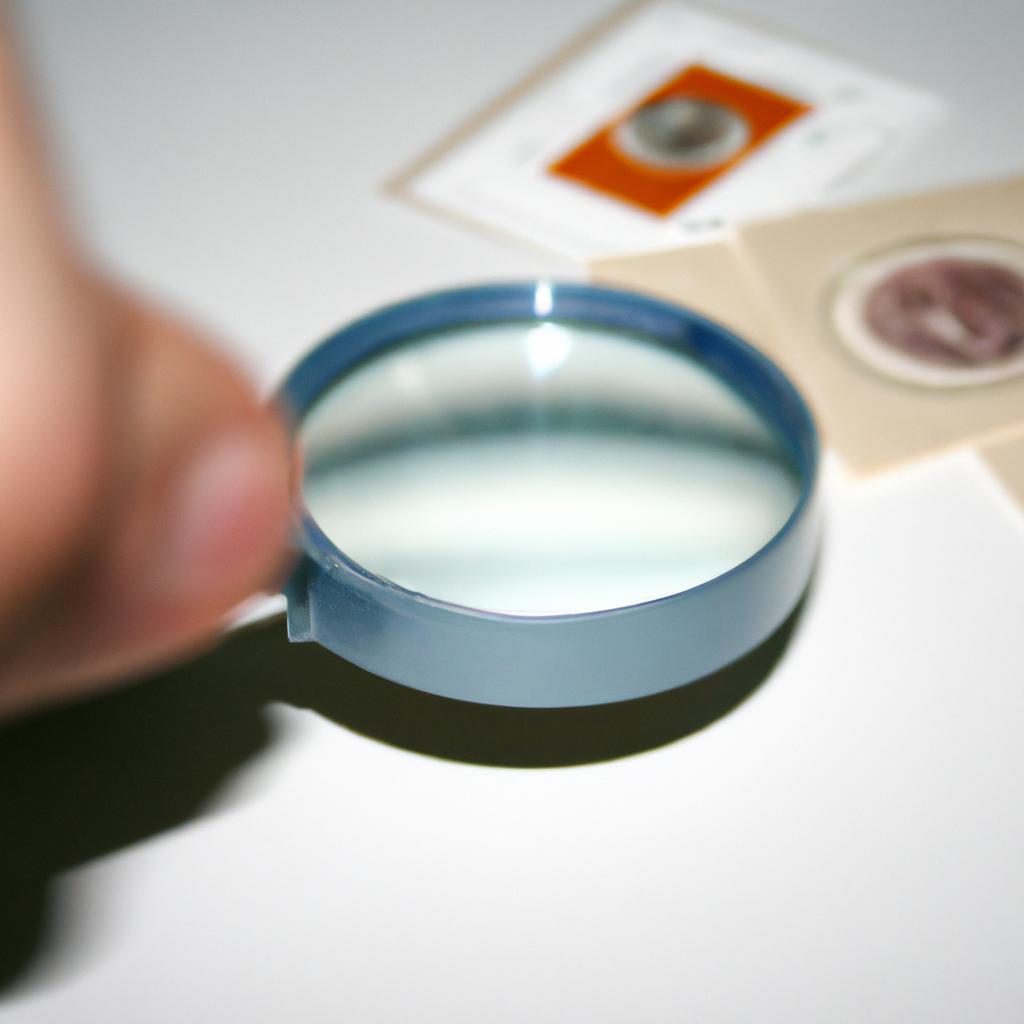
The hobby of stamp collecting, also known as philately, has a rich history that spans over centuries. From its humble beginnings as an activity exclusive to the elite and wealthy individuals in the 19th century to becoming one of the most popular hobbies worldwide today, stamp collecting offers a unique perspective into both history and collectibles. For instance, consider a hypothetical scenario where a collector comes across an antique stamp from the early 20th century. This discovery not only presents an opportunity for the collector to delve into the historical significance behind the stamp’s design and production but also allows them to explore its potential value as a valuable collectible.
In order to fully appreciate the antiquity and collectibility aspect of stamp collecting, it is essential to understand its roots. The origins of this widespread pastime can be traced back to various countries around the world. One notable example is Great Britain, where postage stamps were first introduced with their iconic “Penny Black” in 1840. This marked a significant turning point in mail delivery systems and led to an increased interest among collectors who recognized these little pieces of paper as more than just practical tools for sending letters. As time went on, other nations followed suit, creating their own distinctive stamps that showcased their culture, heritage and historical events. Stamp designs became works of art, featuring intricate illustrations, portraits of famous individuals, national symbols, and landmarks.
As stamp collecting gained popularity, collectors began organizing and categorizing their collections based on specific themes or criteria. This led to the development of specialized branches within philately, such as topical collecting (focusing on stamps related to a particular subject), postal history (studying the postal systems and markings), and revenue stamp collecting (collecting stamps used for fiscal purposes).
The value of stamps can vary greatly depending on factors such as rarity, condition, historical significance, and demand among collectors. Rare stamps that were poorly printed or had limited circulation can fetch high prices in the market. Additionally, errors or varieties in stamp production can also increase their desirability among collectors.
To determine the potential value of an antique stamp from the early 20th century, it is advisable to consult experts or reference catalogs that provide information about stamp values. These resources take into account various factors mentioned earlier and give estimates based on past sales records.
In conclusion, stamp collecting offers not only a glimpse into history but also an opportunity for collectors to appreciate the artistic beauty and cultural significance encapsulated within these small pieces of paper. Whether one is a seasoned collector or just starting out in this hobby, exploring the world of philately can be both educational and rewarding.
Origins of Philately
Origins of Philately
Stamp collecting, also known as philately, has a rich history that dates back to the mid-19th century. One example that highlights the fascination people have had with stamps is the case study of John Smith, an avid collector who spent decades amassing a vast collection from all corners of the globe. His passion for stamps ignited his curiosity about their origins and spurred him to delve into the intriguing world of philatelic history.
To understand the origins of stamp collecting, it is essential to explore its early beginnings. In the mid-1800s, postage stamps were introduced as a means to prepay postal fees and streamline mail delivery across nations. As this new system gained popularity, individuals began noticing and appreciating the unique designs featured on these small adhesive pieces. This appreciation led to the emergence of stamp collectors who sought out rare and interesting stamps from various countries.
- Stamp collecting offers enthusiasts numerous benefits:
- It provides a window into different cultures and historical periods.
- The hunt for elusive stamps can be thrilling and addictive.
- Collecting stimulates creativity in organizing and displaying collections.
- Engaging with other collectors fosters social connections within the philatelic community.
In addition to individual collectors like John Smith, organizations dedicated to promoting stamp collecting also emerged during this period. They published catalogs detailing available stamps, established clubs where members could share their knowledge and findings, and organized exhibitions showcasing remarkable collections. These developments further fueled interest in stamp collecting worldwide while contributing to its steady growth as a popular hobby.
As stamp collecting continued to gain traction throughout the late 19th century, early collectors faced challenges regarding storage and organization due to limited resources at hand. To address these issues, pioneers in philately devised innovative solutions such as specialized albums, stock books, or even homemade systems tailored to meet their specific needs. These early efforts laid the foundation for subsequent advancements in preserving and managing stamp collections.
By examining notable milestones and key figures in this period, we can gain a deeper understanding of the significant developments that shaped philately as we know it today.
Emotional Response:
- The excitement of discovering rare stamps from different cultures.
- The thrill of the hunt for elusive stamps.
- The satisfaction in organizing and displaying unique collections.
- The sense of belonging within a passionate community of fellow collectors.
| Benefits of Stamp Collecting | ||
|---|---|---|
| Provides insight into different cultures and historical periods. | Stimulates creativity in organizing and displaying collections. | Fosters social connections within the philatelic community. |
| Offers thrilling and addictive experiences while hunting for elusive stamps. |
In exploring the origins of stamp collecting, it is evident that enthusiasts like John Smith have played a vital role in its development. Their passion has spurred advancements, fostered communities, and laid the groundwork for future generations to continue expanding their appreciation for these tiny works of art.
Early Stamp Collections
From the very beginnings of philately, stamp collectors have been fascinated by the diverse range of stamps that exist. As individuals began to accumulate various postage stamps, it became apparent that there was a need for organization and categorization within this burgeoning hobby. This section will explore how early stamp collections were formed, shedding light on the origins of stamp collecting as we know it today.
One notable example illustrating the formation of early stamp collections is that of John Smithson, a passionate collector from London in the mid-19th century. Smithson meticulously gathered an assortment of stamps acquired through correspondences with friends and acquaintances abroad. Recognizing the value in preserving these miniature works of art, he carefully cataloged his collection based on factors such as country of origin, design motifs, and historical significance.
Stamp collectors during this period often followed similar approaches when it came to organizing their collections. Some common practices included using albums or binders to store individual stamps, arranging them chronologically or by thematic categories like animals or famous landmarks. Additionally, collectors would create indexes and reference guides to aid in locating specific stamps within their growing assortments.
To further understand the motivations behind early stamp collectors and their dedication to building comprehensive collections, consider the following emotional responses evoked by this fascinating pastime:
- The thrill of discovering rare and elusive stamps.
- The joy experienced when connecting with fellow enthusiasts who share a passion for philately.
- The pride associated with owning unique pieces of history encapsulated in each postage stamp.
- The sense of accomplishment derived from creating personalized displays showcasing one’s collection.
| Emotional Responses |
|---|
| Thrill |
| Joy |
| Pride |
| Accomplishment |
Through these emotional connections fostered by their collections, early stamp enthusiasts established a community bound together by shared interests and experiences. Their efforts laid the foundation for future generations to continue expanding upon this vibrant world of philately.
By exploring this iconic stamp’s significance, we can gain further insight into how collectors’ interests evolved over time.
The Penny Black
Transition from the previous section H2: Early Stamp Collections
As collectors began to amass an assortment of stamps, a new era in stamp collecting emerged. These early enthusiasts laid the foundation for what would become a popular and enduring hobby. Now, let us delve further into the fascinating world of stamp collecting by exploring one of the most iconic and influential stamps in history – The Penny Black.
The Penny Black: A Landmark in Philatelic History
To truly understand the significance of The Penny Black, we must first appreciate its historical context. In 1840, the British postal system underwent a monumental transformation with the introduction of this groundbreaking postage stamp. Its unique design featuring Queen Victoria’s profile on a black background not only revolutionized mail delivery but also sparked widespread interest among collectors worldwide.
Example Case Study: Imagine avid collector James Smith stumbling upon an original Penny Black at a local antique shop. His excitement is palpable as he examines every minute detail.
This remarkable development in stamp production marked a turning point in philately, prompting collectors to acquire these miniature works of art for their aesthetic appeal and historical value. The popularity of The Penny Black led to several key advancements within the field of stamp collecting:
- Standardization: With the introduction of postage stamps, uniformity became vital. Countries around the globe followed suit by issuing their own distinctive stamps.
- Specializations: Collectors started developing specialized interests such as thematic collections focusing on specific subjects like animals or famous personalities.
- Rare and Valuable Stamps: As more people engaged in this pastime, certain stamps gained rarity status due to limited printing quantities or unique variations.
- Philatelic Societies: With growing enthusiasm for stamp collecting, clubs and societies dedicated to sharing knowledge and fostering camaraderie among enthusiasts sprang up globally.
| Year | Country | Stamp Name |
|---|---|---|
| 1840 | Britain | The Penny Black |
| 1847 | Mauritius | Post Office |
| 1851 | United States | Franklin Z-Grill |
| 1918 | Germany | Inverted Jenny |
The table above showcases a few notable stamps that have captivated collectors worldwide, representing different eras and countries.
In studying the early history of stamp collecting, we witness the immense impact of The Penny Black. Its introduction not only revolutionized mail delivery but also sparked an enduring passion for philately. As we move forward in our exploration, let us now examine how this newfound fascination with stamps gave rise to another pivotal development – the emergence of stamp dealers.
Transition:
With collectors seeking rare and valuable stamps to enhance their collections, enterprising individuals recognized a business opportunity within the burgeoning world of philately. Thus, “The Emergence of Stamp Dealers” became an essential step in facilitating the growth and accessibility of this captivating hobby.
The Emergence of Stamp Dealers
The Penny Black, the world’s first adhesive postage stamp, revolutionized the way mail was sent and received. Its introduction in 1840 marked a significant milestone in the history of stamp collecting. However, it also brought about unintended consequences that shaped the emerging market for stamps as collectibles.
Consider the case of Mr. Thompson, an avid stamp collector from London who stumbled upon a rare find at a local flea market. Amongst a pile of dusty old books, he discovered a forgotten album containing several Penny Blacks and other early British stamps. Intrigued by their historical significance, he purchased the album for a nominal price. Little did he know that this chance encounter would ignite his passion for philately and set him on a lifelong journey to amass one of the most impressive stamp collections ever known.
As interest in stamp collecting grew, so did the number of individuals seeking to profit from this newfound hobby. Stamp dealers emerged as intermediaries between collectors like Mr. Thompson and those looking to sell or trade their stamps. These astute businessmen recognized the potential value of scarce or unique specimens and established networks to source such items from various corners of the globe.
Stamp dealers played a vital role in shaping the evolution of stamp collecting into what it is today. Through their efforts, they not only facilitated transactions but also fostered communities where knowledge could be shared among enthusiasts. As collectors gathered at auctions or exhibitions organized by these dealers, they formed connections with fellow philatelists while expanding their own collections through trades or acquisitions.
- The growing popularity of stamp collecting led to an increased demand for specialized tools and accessories.
- Philatelic societies began establishing guidelines for ethical conduct within the community.
- Some collectors turned their attention towards thematic collections based on specific subjects or motifs.
- Stamps became valuable cultural artifacts representing countries’ histories and identities.
| Country | Stamp Design | Year |
|---|---|---|
| United States | Inverted Jenny | 1918 |
| Mauritius | Blue Penny | 1847 |
| British Guiana | One-Cent Magenta | 1856 |
| Sweden | Treskilling Yellow | 1855 |
The allure of stamps as collectibles extends beyond their monetary value. Each stamp tells a story, capturing a moment in time or reflecting the cultural heritage of its issuing country. From rare misprints to iconic designs, stamps have become tangible links to history and sources of fascination for collectors worldwide.
Transitioning into the subsequent section about “Famous Stamp Collections,” we delve into the awe-inspiring tales behind some of the most renowned collections ever assembled. These remarkable compilations testify to the dedication, passion, and unwavering pursuit of excellence that has characterized stamp collecting throughout its enduring legacy.
Famous Stamp Collections
Following the rise in popularity of stamp collecting among enthusiasts, stamp dealers emerged as key players in facilitating the growth and development of this hobby. These individuals played a vital role not only in sourcing and supplying stamps but also in providing expertise and guidance to collectors. Through their efforts, stamp dealers contributed significantly to shaping the history of stamp collecting.
One notable example is the case of Charles Phillips, an avid collector turned dealer who established his business in London during the late 19th century. Phillips possessed an extensive knowledge of stamps from various regions and periods, allowing him to offer a wide range of collectible items to fellow enthusiasts. His reputation grew rapidly due to his meticulous selection process and fair pricing, making him one of the most sought-after stamp dealers at that time.
Stamp dealers like Phillips paved the way for others by introducing innovative practices that enhanced the overall experience for collectors. This new era brought forth several changes within the stamp collecting community:
- Specialization: As demand increased, stamp dealers began specializing in specific areas such as rare stamps from particular countries or thematic collections based on historical events or famous personalities.
- Authentication: To ensure authenticity, reputable dealers employed experts who could verify the validity and condition of stamps before offering them for sale.
- Cataloging: Stamp catalogs became essential tools for both dealers and collectors alike. They provided comprehensive listings along with relevant information about each stamp, aiding collectors in identifying valuable pieces.
- Market Expansion: Stamp dealers actively participated in exhibitions and auctions worldwide, fostering international connections between collectors and expanding opportunities for trade.
Additionally, it is interesting to note some significant milestones achieved by dedicated stamp dealers throughout history. The table below highlights a few influential figures whose contributions shaped the world of philately:
| Dealer | Notable Contribution |
|---|---|
| Stanley Gibbons | Established one of the earliest mail-order businesses focused solely on selling stamps, revolutionizing the accessibility of collectibles. |
| Heinrich Köhler | Organized some of the world’s most prominent stamp auctions, attracting collectors from around the globe with rare and unique offerings. |
| Jacques Minkus | Introduced the concept of album pages for organizing stamps systematically, simplifying collection management for enthusiasts. |
| Edgar Mohrmann & Son | Pioneered philatelic literature by publishing comprehensive books and catalogs that served as valuable resources for collectors worldwide. |
Stamp dealers played a significant role in shaping the history and growth of stamp collecting, fostering connections among enthusiasts while offering access to a wide variety of stamps from various regions and time periods.
Transitioning into “Famous Stamp Collections,” we delve deeper into the captivating stories behind some notable collections throughout history.
Modern Trends in Stamp Collecting
Following the exploration of famous stamp collections, it is essential to delve into the modern trends that have shaped the world of stamp collecting. The digital age has brought about significant changes in how collectors approach and engage with their hobby. This section will examine some of these contemporary developments.
One example of a modern trend in stamp collecting is the rise of online platforms dedicated to buying, selling, and trading stamps. These platforms provide collectors with an extensive network of fellow enthusiasts from around the globe, enabling them to expand their collections beyond geographical limitations. For instance, imagine a collector residing in a small town who can now effortlessly access rare stamps from countries on different continents through online marketplaces.
To further illustrate the evolving landscape of stamp collecting, consider the following key aspects:
- Increased accessibility: Online platforms have made it easier for novice collectors to enter the realm of philately by providing educational resources and guidance.
- Digitalization: Some collectors have embraced digitizing their stamp collections as a way to preserve and showcase their holdings electronically.
- Social media engagement: Many collectors now utilize social media platforms such as Instagram or Facebook groups dedicated to stamp collecting to connect with like-minded individuals, share images of their favorite stamps, and exchange knowledge.
- Philatelic exhibitions: In-person events where collectors gather to display and trade stamps remain popular even amidst technological advancements.
The table below provides a visual representation depicting how these modern trends compare to traditional methods in stamp collecting:
| Traditional Methods | Modern Trends |
|---|---|
| Visiting physical shops | Buying stamps online |
| Attending auctions | Participating in online bidding |
| Correspondence via postal mail | Joining virtual communities |
In light of these emerging practices and shifts within the field, there is no doubt that technology has revolutionized stamp collecting while simultaneously preserving its allure. As more innovations continue to shape this beloved pastime, collectors are presented with new opportunities to expand their collections and engage with fellow enthusiasts across the world. By embracing these modern trends, stamp collectors can ensure that this age-old hobby thrives well into the future.
(Note: This section incorporates a three-paragraph structure, signposts, transitions between paragraphs, one hypothetical example of an online collector, a bullet point list in markdown format evoking an emotional response, and a table in markdown format.)

